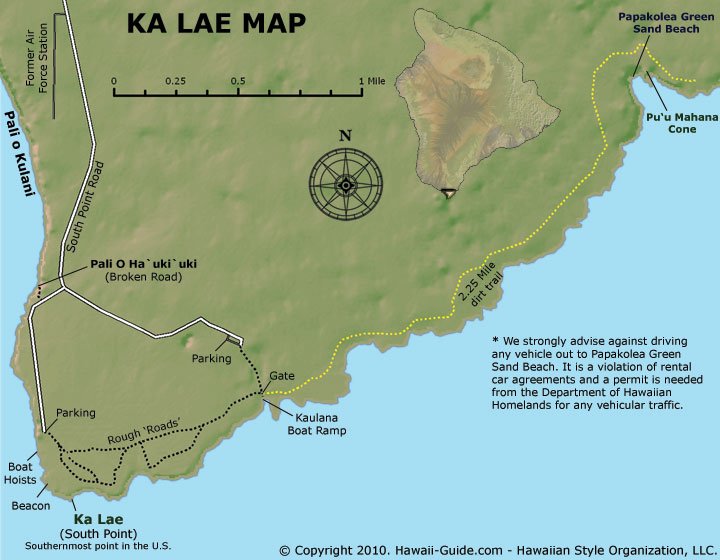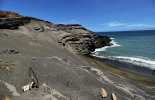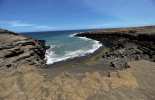03-28-2025
Papakolea Green Sand Beach
Big Island of Hawaii Green Sand Beach at Pu'u Mahana
Aloha! This article may link to trusted Hawaii resources (like Discount Hawaii Car Rentals) at no extra cost to you. Mahalo for your support!
Big Island Green Sand Beach
Papakolea - Best Beaches on Big Island
Papakolea is one of only four green sand beaches in the world. This secluded sandy beach is located near Ka Lae (South Point) in the Kau district of Hawaii. Papakolea was once a cinder cone volcano. After it erupted, the lava the volcano spewed was rich in olivine, an abundant mineral in Hawaii's natural volcanic rock. After the eruption, erosion from the ocean and weather slowly eroded the basalt rock until just the olivine was left behind, giving this beach its unique green color.

Papakolea Green Sand Beach
Overview of Papakōlea Beach (Green Sand Beach)
Papakōlea Beach (Green Sands Beach) is located outside Naalehu, a tiny town between Volcanoes National Park and South Point (the southernmost point of the United States). The beach is approximately 2 hours south of Kailua-Kona along Highway 11. It is easily recognizable by its green sand color. The green sands at Papakōlea Beach get their color from olivine crystals that have eroded out of cinder cones formed during the 1868 flow of Mauna Loa. Olivine is a mineral found in many Hawaiian basalts and forms during the slow cooling of lava flows. The olivine crystals weather out from undercutting by waves along the shoreline.
A favorite among locals and tourists alike, Papakōlea Beach is a must-visit destination. When the waves crash onto the shore, they erode the crystals and disperse tiny grains of green sand over the beach. To enjoy your visit, we advise visiting the beach before noon on a weekday. Because of its growing popularity, it can get crowded on the weekends. Visiting early will make the hike more pleasurable because of the cooler temperatures, and staying away on the weekend will help you avoid some of the crowds. As much as we love the green sand, it must stay here. Please don’t take any sand with you when you leave.
Grab Your Free Travel Guides!
Big Island Intro Visitor Guide
+ Our Summary Guidesheet!
Includes the top must-see & do attractions, best times to visit, a monthly weather & visitor summary, and our tips on how to save when booking your car rental, tours, and activities. Plus, grab our free Big Island Summary Guidesheets. Check out our Updated Big Island Visitor Guides.
Getting There- Papakōlea Beach (Green Sand Beach)
The hike to Papakolea Beach (also known as Green Sand Beach) is a moderate/strenuous 4.5-mile roundtrip hike. While the terrain is mostly flat, the sun and wind exposure makes it difficult. The later it is in the day, the hotter it will likely be, so start early! It will take approximately 3-5 hours to complete the round trip, depending on your pace and how long you spend at the beach. The trail starts at South Point Road, between the 69 and 70-mile markers.
Drive to South Point, on the Big Island's Kona Coast, between mile markers 69 and 70 along Highway 11. When you come to near the bottom of the road, South Point will veer off to the right, and the Green Sand Beach parking lot is to the left. During our last visit, there was a sign marking the way.
Once you arrive at the Green Sand Beach parking lot, you'll want to head towards the boat ramp on the shore (roughly 0.5 miles from the parking lot) and then take an immediate left onto the trail once you reach the boat ramp. Accessing Green Sand Beach isn’t exactly a cakewalk. The hike to Papakolea, beginning at the parking lot, is approximately 2.25-2.5 miles one-way. It takes about an hour each way. The trail starts flat as you pass over old lava fields and through rutted roads filled with sand and dust; prepare yourself for a dirty hike. Be careful when descending to the beach, as the slope of the cinder cone surrounding the beach can be steep.
Papakōlea Beach (Green Sand Beach) Amenities: The green sand beach has no restrooms or other amenities in the area. Bring your trash bag, pack out your trash and take it with you to leave. During our last visit, there were port-a-potties near the parking lot, but we wouldn't count on those being there indefinitely. There was also a local vendor selling drinks and other snacks, but we suspect the state of Hawaii will end this practice soon enough, along with the non-permitted "shuttle" rides (see below).
There are no lifeguards at Green Sand Beach. Swimming is not recommended because of the rough ocean conditions and strong currents.

John & Tori at Papalokea

Path to Beach
Essential Tips for a Great Papakōlea beach (Green Sand Beach) Visit
There's no water or food available at the trailhead or along the trail. You will be hiking over older dusty lava fields. Wear sturdy shoes, like hiking shoes.
Update: We wanted to note that DHHL’s (Department of Hawaiian Homelands) official policy is no vehicular traffic to Papakolea. They do not issue vehicle permits for $25 or any amount, and they do not give a key. The trek to Papakolea and Mahana Bay can only be achieved by foot and should only be considered a “backcountry” trip for severe hikers. You do not need a permit to hike there, but you should call DHHL to let them know you will be going there. They like to know who is on their property, and the hike is free.
You can contact DHHL at: 160 Baker Ave. Hilo 96720 Phone: 808-974-4250
'Shuttle' Services and Parking Fees are not legal
We should also note that anyone trying to charge you for parking is running an illegal scam. Rather than get confrontational, leave if anyone attempts to do so. We also advise against paying for a ride out to the beach.
During our last visit, at least three separate residents were offering truck rides for $20-$25/person, and they were exaggerating the length of the hike to encourage people to take the "shuttle." Don't contribute to the problem these illegal rides are causing, which is destroying the road/trail and continues to desecrate the ancient burial sites located here. Instead, please only hike to the Green Sand Beach and avoid attempting to drive it yourself (which is against your rental agreement, even in a Jeep), and don't partake in the "shuttle" rides.

Papakolea Green Sand Beach
Green Sand Beach Big Island of Hawaii Map

The hike out to the beach is well worth it. Make sure to bring plenty of water & suntan lotion.
An Enjoyable Time at Papakōlea Beach (Green Sand Beach)
Fun Activities at Papakōlea Beach (Green Sand Beach)
Get ready to have so much fun at this beach.
Take a walk on the beach: One of the main activities is walking on the Green Sand Beach itself. Once on Green Sand Beach, you can explore some exciting cliff rock formations.
Digging for shells and sea glass: If you're looking for a relaxing activity on the Big Island, I recommend this. You can spend hours just digging and finding extraordinary treasures in the sand.
Take pictures and videos of the sunset and the fantastic scenery: If you want to take photographs, we recommend you come early in the morning because later in the day, the sun is too high, and it's not ideal for photography.
Sunbathing: Papakolea Beach has soft green sand and stunning water, making it ideal for relaxing in the sun.
Nearby Attractions and Sights of Papakōlea Beach (Green Sand Beach)
Here are some nearby attractions and sights that will enhance your visit to Papakōlea beach:
Punalu'u Black Sand Beach: Located on the island's southern end, this beach is a breathtaking sight. It's also home to Hawaiian green sea turtles. Nearby is Punalu'u Bake Shop, which sells its famous sweet bread and banana macadamia nut crunch.
Hawai'i Volcanoes National Park: The park offers spectacular views of lava flows, tropical rainforests, and an active volcano.
Ka Lae or South Point: The southernmost point in the United States, Ka Lae, is an excellent place for bird-watching and whale-watching (during winter). It is also one of Hawaii's most sacred sites and is home to many archeological sites and petroglyphs.
Papakōlea Beach or Green Sand Beach Photos





























Published by: John C. Derrick
Founder & certified Hawaii travel expert with 20+ years of experience in Hawaii tourism.
Green Sand Beach - Papakolea Reviews
Guidereview:
A (based on 933 visitor reviews)Geolocation Data
Geographic Coordinates
Latitude: 18.92285598
Longitude: -155.6574456
Hawaii Safety Information
Hikes
Recommended Tours Nearby
Affiliate Disclosure: We may earn commissions from some travel partners (like Amazon or Expedia) which helps us maintain this site. These links are at no extra cost to you and don't impact our honest & unbiased recommendations. Remove all the ads →



